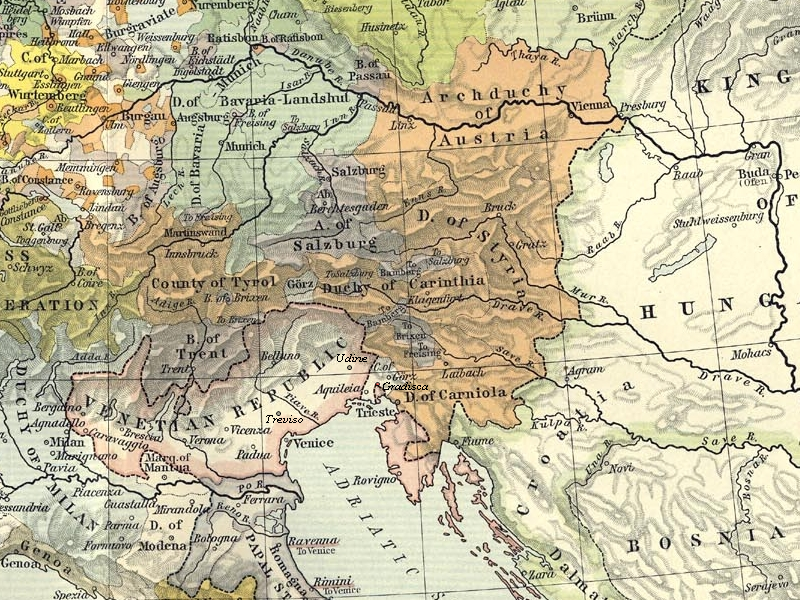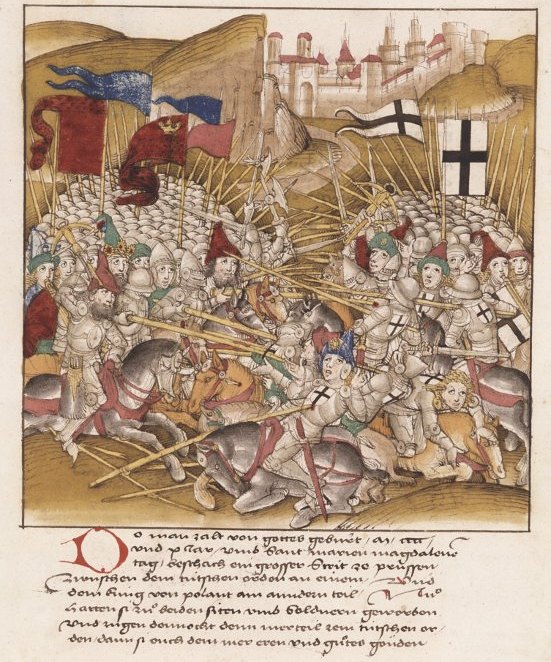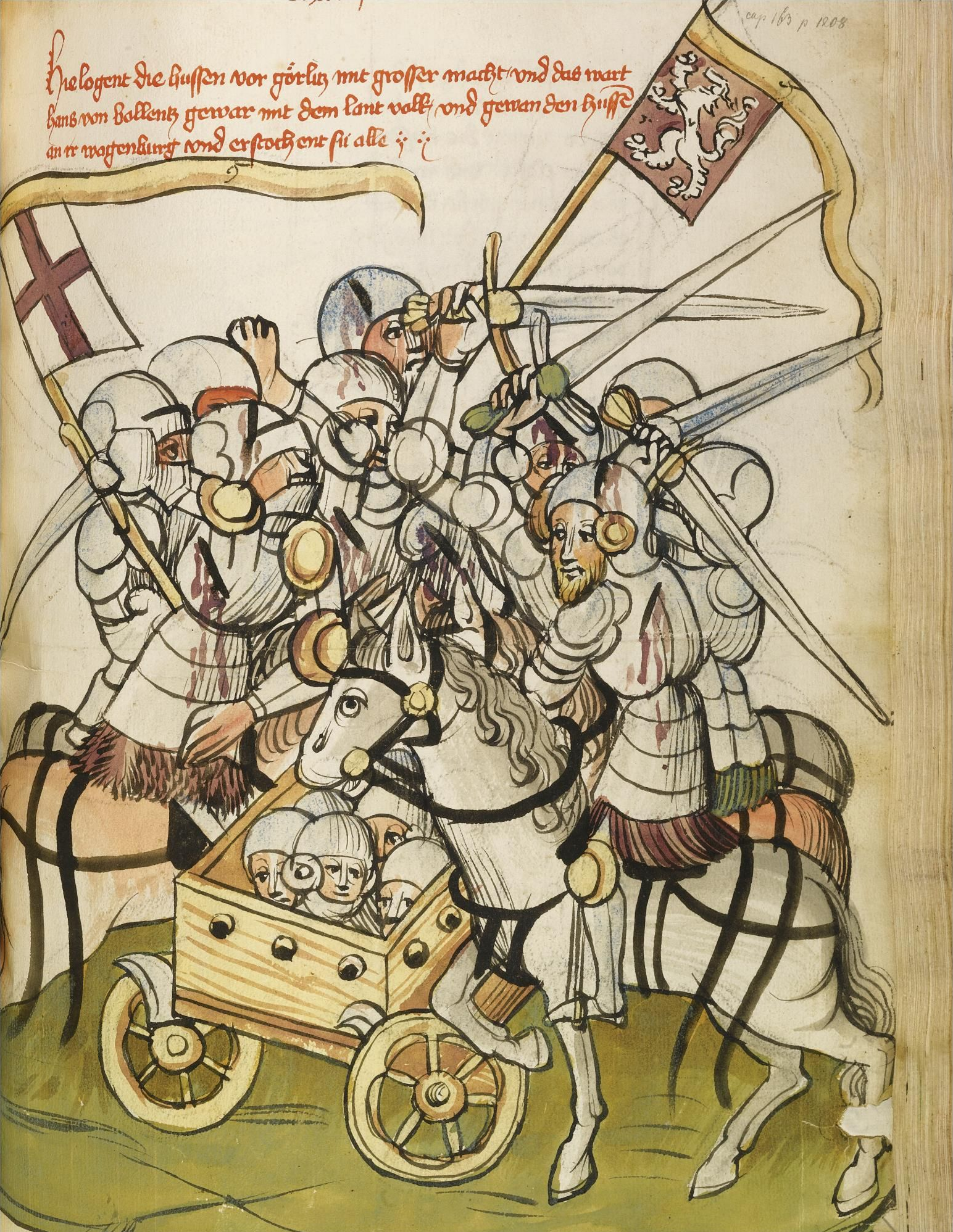|
Austrian–Hungarian War (1477–1488)
The Austrian–Hungarian War was a military conflict between the Kingdom of Hungary under Matthias Corvinus and the Habsburg Archduchy of Austria under Frederick V (also Holy Roman Emperor as Frederick III). The war lasted from 1477 to 1488 and resulted in significant gains for Matthias, which humiliated Frederick, but which were reversed upon Matthias' sudden death in 1490. Conflict Matthias and Frederick III/V had been rivals stretching back to Matthias' succession as King of Hungary in 1458 after the early death of Frederick's Habsburg cousin King Ladislaus the Posthumous. At this time, Frederick held the Holy Crown of Hungary and was a candidate for becoming Hungarian king himself. Matthias, backed by the Bohemian king George of Poděbrady whose daughter Catherine (1449–1464) he married in 1461, finally prevailed: the two rivals settled their disagreements in 1463 with the Treaty of Wiener Neustadt, in which Frederick recognized the ''de facto'' King of Hungary and returned ... [...More Info...] [...Related Items...] OR: [Wikipedia] [Google] [Baidu] |
Lower Austria
Lower Austria ( , , abbreviated LA or NÖ) is one of the nine states of Austria, located in the northeastern corner of the country. Major cities are Amstetten, Lower Austria, Amstetten, Krems an der Donau, Wiener Neustadt and Sankt Pölten, which has been the capital city, capital of Lower Austria since 1986, replacing Vienna, which became a separate state in 1921. With a land area of and a population of 1.7 million people, Lower Austria is the largest and second-most-populous state in Austria (after Vienna). Geography With a land area of situated east of Upper Austria, Lower Austria is the country's largest state. Lower Austria derives its name from its downriver location on the river Enns (river), Enns, which flows from the west to the east. Lower Austria has an international border, long, with the Czech Republic (South Bohemian Region, South Bohemia and South Moravian Region, South Moravia) and Slovakia (Bratislava Region, Bratislava and Trnava Regions). The state has the ... [...More Info...] [...Related Items...] OR: [Wikipedia] [Google] [Baidu] |
Catherine Of Poděbrady
Catherine of Poděbrady (11 November 1449 – 8 March 1464) was Queen of Hungary as the second wife of King Matthias Corvinus. Biography Catherine and her twin sister Sidonie were born at Poděbrady, to the Bohemian king George of Poděbrady and his first wife, Kunigunde of Šternberk. Kunigunde died from complications of the birth. George of Poděbrady eventually remarried; his second wife, Joanna of Rožmitál, bore George more children, including Ludmila of Poděbrady. Matthias Corvinus had lost his wife, Elisabeth of Cilli, at a young age. On 1 May 1463 he married Catherine at Matthias Church in Buda. Matthias was eighteen, his bride thirteen. The wedding negotiations had begun in 1458 when Catherine was nine years old. Soon after the marriage, Catherine left her family and went to live in Hungary with her new husband. Janus Pannonius helped teach Catherine Latin. The queen died in childbirth at the age of 14. Her child died as well. The event caused Matthias to lose ho ... [...More Info...] [...Related Items...] OR: [Wikipedia] [Google] [Baidu] |
Treaty Of Brno (1478)
The Treaty of Brno was a draft to the Peace of Olomouc developed in March 1478 in Brno by the envoys of Matthias Corvinus of Hungary and King Vladislaus II of Bohemia and Hungary in an effort to end the Bohemian–Hungarian War (1468–1478). Corvinus accepted the accord and slightly modified it on 20 September 1478, which determined the division of Bohemian territories. Based on the terms of the treaty, Vladislaus would cede the territories of Moravia, Silesia, and Lusatia to Corvinus. If Matthias perished, then Vladislaus was permitted to redeem these lands for 400,000 florins. Moreover, both monarchs would be permitted to utilize the title ''King of Bohemia''. However, only Matthias was required to address the other claimant as the ''King of Bohemia''.Engel, p. 305. ''The division of the lands belonging to the Bohemian crown, which was made by the envoys of Mathias and Wladislas at Brno in March 1478, was accepted by the king of Hungary, with minor modifications, on 20 September. ... [...More Info...] [...Related Items...] OR: [Wikipedia] [Google] [Baidu] |
Vladislaus II Of Hungary
Vladislaus II, also known as Vladislav, Władysław or Wladislas (; 1 March 1456 – 13 March 1516), was King of Bohemia from 1471 to 1516 and King of Hungary and King of Croatia from 1490 to 1516. As the eldest son of Casimir IV Jagiellon, he was expected to inherit the Kingdom of Poland, Crown Kingdom of Poland and adjacent Grand Duchy of Lithuania. George of Poděbrady, the Hussites, Hussite (followers of late 14th-early 15th centuries and pre-Protestantism, Protestant Bohemia, Bohemian Protestant Reformers, Reformer in the Catholic Church, Roman Catholic Church of persecuted theologian John Hus, 1370–1415) ruler of Bohemia, offered to make Vladislaus his heir in 1468. George needed Casimir's support against the rebellious Catholic, Roman Catholic noblemen and their ally King of Hungary Matthias Corvinus. The Diet of Bohemia elected Vladislaus king after George's death, but he could rule only Bohemia proper because Matthias, whom the Roman Catholic nobles had elected king, occ ... [...More Info...] [...Related Items...] OR: [Wikipedia] [Google] [Baidu] |
History Of Poland During The Jagiellonian Dynasty
The rule of the Jagiellonian dynasty in Poland between 1386 and 1572 spans the Late Middle Ages and the Early Modern Period in European history. The Lithuanian Grand Duke Jogaila (Władysław II Jagiełło) founded the dynasty; his marriage to Queen Jadwiga of Poland in 1386 strengthened an ongoing Polish–Lithuanian union. The partnership brought vast territories controlled by the Grand Duchy of Lithuania into Poland's sphere of influence and proved beneficial for both the Polish and Lithuanian people, who coexisted and cooperated in one of the largest political entities in Europe for the next four centuries. In the Baltic Sea region, Poland engaged in ongoing conflict with the Teutonic Knights. The struggles led to a major battle, the Battle of Grunwald of 1410, but there was also the milestone Peace of Thorn of 1466 under King Casimir IV Jagiellon; the treaty defined the basis of the future Duchy of Prussia. In the south, Poland confronted the Ottoman Empire and the Cri ... [...More Info...] [...Related Items...] OR: [Wikipedia] [Google] [Baidu] |
Prague
Prague ( ; ) is the capital and List of cities and towns in the Czech Republic, largest city of the Czech Republic and the historical capital of Bohemia. Prague, located on the Vltava River, has a population of about 1.4 million, while its Prague metropolitan area, metropolitan area is home to approximately 2.3 million people. Prague is a historical city with Romanesque architecture, Romanesque, Czech Gothic architecture, Gothic, Czech Renaissance architecture, Renaissance and Czech Baroque architecture, Baroque architecture. It was the capital of the Kingdom of Bohemia and residence of several Holy Roman Emperors, most notably Charles IV, Holy Roman Emperor, Charles IV (r. 1346–1378) and Rudolf II, Holy Roman Emperor, Rudolf II (r. 1575–1611). It was an important city to the Habsburg monarchy and Austria-Hungary. The city played major roles in the Bohemian Reformation, Bohemian and the Protestant Reformations, the Thirty Years' War and in 20th-century history a ... [...More Info...] [...Related Items...] OR: [Wikipedia] [Google] [Baidu] |
Olomouc
Olomouc (; ) is a city in the Czech Republic. It has about 103,000 inhabitants, making it the Statutory city (Czech Republic), sixth largest city in the country. It is the administrative centre of the Olomouc Region. Located on the Morava (river), Morava River, the city is the ecclesiastical metropolis and was a historical co-capital city of Moravia, before having been occupied by the Military of the Swedish Empire, Swedish army during the Thirty Years' War. The historic city centre is well preserved and is protected as Cultural monument (Czech Republic)#Monument reservations, urban monument reservation. The Holy Trinity Column in Olomouc, Holy Trinity Column was listed as a UNESCO World Heritage Site in 2000 for its quintessential Baroque architecture, Baroque style and symbolic value. Administrative division Olomouc consists of 26 municipal parts (in brackets population according to the 2021 census): *Olomouc (13,446) *Bělidla (834) *Černovír (1,010) *Chomoutov (1,070) *Ch ... [...More Info...] [...Related Items...] OR: [Wikipedia] [Google] [Baidu] |
Lusatia
Lusatia (; ; ; ; ; ), otherwise known as Sorbia, is a region in Central Europe, formerly entirely in Germany and today territorially split between Germany and modern-day Poland. Lusatia stretches from the Bóbr and Kwisa rivers in the east to the Pulsnitz and Black Elster rivers in the west, and is located within the German states of Saxony and Brandenburg as well as in the Polish voivodeships of Lower Silesia and Lubusz. Major rivers of Lusatia are the Spree and the Lusatian Neisse, which defines the border between Germany and Poland. The Lusatian Mountains of the Western Sudetes separate Lusatia from Bohemia (Czech Republic) in the south. Lusatia is traditionally divided into Upper Lusatia, the hilly southern part, and Lower Lusatia, the flat northern part. The areas east and west along the Spree in the German part of Lusatia are home to the Slavic Sorbs, one of Germany’s four officially recognized indigenous ethnic minorities. The Upper Sorbs inhabit Saxon U ... [...More Info...] [...Related Items...] OR: [Wikipedia] [Google] [Baidu] |
Silesia
Silesia (see names #Etymology, below) is a historical region of Central Europe that lies mostly within Poland, with small parts in the Czech Silesia, Czech Republic and Germany. Its area is approximately , and the population is estimated at 8,000,000. Silesia is split into two main subregions, Lower Silesia in the west and Upper Silesia in the east. Silesia’s culture reflects its complex history and diverse influences, blending Polish, Czech, and German elements. The region is known for its distinctive Silesian language (still spoken by a minority in Upper Silesia), richly decorated folk National costumes of Poland, costumes, hearty regional Silesian cuisine, cuisine, and a mix of Gothic, Baroque, and industrial-era Silesian architecture, architecture seen in its cities and towns. The largest city of the region is Wrocław. Silesia is situated along the Oder River, with the Sudeten Mountains extending across the southern border. The region contains many historical landmarks ... [...More Info...] [...Related Items...] OR: [Wikipedia] [Google] [Baidu] |
Hussite
file:Hussitenkriege.tif, upright=1.2, Battle between Hussites (left) and Crusades#Campaigns against heretics and schismatics, Catholic crusaders in the 15th century file:The Bohemian Realm during the Hussite Wars.png, upright=1.2, The Lands of the Bohemian Crown during the Hussite Wars. The movement began during the Renaissance in Prague and quickly spread south and then through the rest of the Kingdom of Bohemia. Eventually, it expanded into the remaining domains of the Bohemian Crown as well. The Hussites (Czech language, Czech: ''Husité'' or ''Kališníci'', "Chalice People"; Latin: ''Hussitae'') were a Czech Proto-Protestantism, proto-Protestant Christian movement influenced by both the Byzantine Rite and John Wycliffe that followed the teachings of reformer Jan Hus (floruit, fl. 1401–1415), a part of the Bohemian Reformation. The Czech lands had originally been Christianized by Byzantine Empire, Byzantine Greek missionaries Saints Cyril and Methodius, who introduced the ... [...More Info...] [...Related Items...] OR: [Wikipedia] [Google] [Baidu] |
Catholic Church
The Catholic Church (), also known as the Roman Catholic Church, is the List of Christian denominations by number of members, largest Christian church, with 1.27 to 1.41 billion baptized Catholics Catholic Church by country, worldwide as of 2025. It is among the world's oldest and largest international institutions and has played a prominent role in the history and development of Western civilization.Gerald O'Collins, O'Collins, p. v (preface). The church consists of 24 Catholic particular churches and liturgical rites#Churches, ''sui iuris'' (autonomous) churches, including the Latin Church and 23 Eastern Catholic Churches, which comprise almost 3,500 dioceses and Eparchy, eparchies List of Catholic dioceses (structured view), around the world, each overseen by one or more Bishops in the Catholic Church, bishops. The pope, who is the bishop of Rome, is the Papal supremacy, chief pastor of the church. The core beliefs of Catholicism are found in the Nicene Creed. The ... [...More Info...] [...Related Items...] OR: [Wikipedia] [Google] [Baidu] |
Bohemian War (1468-1478)
The Hussite Wars, also called the Bohemian Wars or the Hussite Revolution, were a series of civil wars fought between the Hussites and the combined Catholic forces of Holy Roman Emperor Sigismund, the Papacy, and European monarchs loyal to the Catholic Church, as well as various Hussite factions. At a late stage of the conflict, the Utraquists changed sides in 1432 to fight alongside Roman Catholics and opposed the Taborites and other Hussite factions. These wars lasted from 1419 to approximately 1434. The unrest began after pre-Protestant Christian reformer Jan Hus was executed by the Catholic Church in 1415 for heresy. Because Sigismund had plans to be crowned the Holy Roman Emperor (requiring papal coronation), he suppressed the religion of the Hussites, yet it continued to spread. When King Wenceslaus IV of Bohemia, brother of Sigismund, died of natural causes a few years later, the tension stemming from the Hussites grew stronger. In Prague and various other parts of ... [...More Info...] [...Related Items...] OR: [Wikipedia] [Google] [Baidu] |





